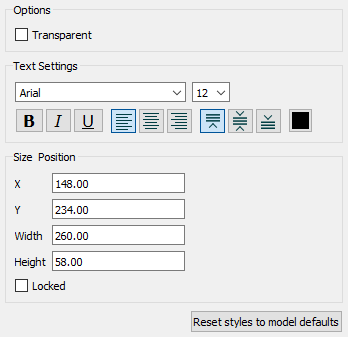
Use the Text Box Properties panel to format the text that appears in a text box.

This specifies what border, if any, should appear around the text box.
Border Style can be either Solid or None. If you select None, the remaining settings won't matter.
Border Thickness lets you specify how thick, in points, you want the border around the Graphics box to be. This has an effect only when you've selected Solid for the Border Style.
Border Color lets you specify the color of the border. Click on the displayed color button to select a color. This has an effect only when you've selected Solid for the Border Style.
Type in the text that you want to appear. If you leave this blank, the words "Enter text here..." will appear on the model diagram.
Tip: If you want to enter just the box and no text, use a Graphics box.
Padding lets you specify the padding of the text relative to the boundary of the text box. This is most useful when you have specified a visible border.
Transparent Background, if checked, will allow you to place the text box on top of other objects without hiding them.
Note: Clicking on objects behind a transparent text box will select the text box, not the object it appears you're clicking on.
In addition to these properties, the Text box has some style properties not found on other objects.

In addition to the standard font selection and Size settings, you can specify the alignment of the text relative to the containing Text box.

Specify the horizontal alignment (left, center, or right), and the vertical alignment (top, center, or bottom).
Tip: If you're using the text box to add labels to a Causal Loop Diagram (CLD) you should switch to using a Loop Labels (Model) instead.